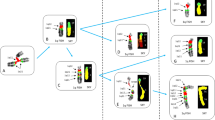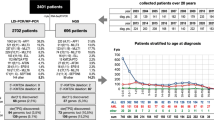Abstract
Jumping translocations (JT) are characterized by the relocalization of the same part of a donor to several recipient chromosomes. Although JT occasionally are constitutional, most are associated with hematologic malignancies. In such cases, JT usually arise during disease progression and are associated with poor prognosis. Despite its clinical importance, this cytogenetic phenomenon has not been characterized at the molecular level. We have analyzed JT in a juvenile chronic myelomonocytic leukemia that subsequently transformed to an acute myeloid leukemia. Detailed fluorescence in situ hybridization (FISH) analyses showed that the cytogenetically identical donor breakpoint at 3q21 was highly heterogeneous. In fact, more than 10 distinct breakpoints, four of which mapped within YACs, were identified. Analyses of samples during disease progression showed that the breakpoint complexity decreased, indicating clonal selection. Hence, the 3q21 breakpoints displayed a spatial as well as a temporal heterogeneity, revealing that JT are highly unstable, showing great variation in the size of donor segment. The breaks at the recipient chromosomes were mapped within the subtelomeric regions. The general telomere length was not affected and an underlying replication error resulting in microsatellite instability was excluded. We conclude that the emergence of JT is unlikely to cause fusion genes or to affect the expression of genes located in the breakpoint regions. The identification of YACs spanning the breakpoints, ie, YACs 913c7, 937g5, 948c2 and 955g1, may facilitate the isolation of DNA sequences leading to a genetic instability associated with the origin of multiple translocations.
This is a preview of subscription content, access via your institution
Access options
Subscribe to this journal
Receive 12 print issues and online access
$259.00 per year
only $21.58 per issue
Buy this article
- Purchase on Springer Link
- Instant access to full article PDF
Prices may be subject to local taxes which are calculated during checkout
Similar content being viewed by others
Author information
Authors and Affiliations
Rights and permissions
About this article
Cite this article
Andreasson, P., Höglund, M., Jonson, T. et al. Molecular characterization of jumping translocations reveals spatial and temporal breakpoint heterogeneity. Leukemia 12, 1411–1416 (1998). https://doi.org/10.1038/sj.leu.2401108
Received:
Accepted:
Published:
Issue Date:
DOI: https://doi.org/10.1038/sj.leu.2401108
Keywords
This article is cited by
-
Jumping translocation in acute monocytic leukemia (M5b) with alternative breakpoint sites in the long arm of donor chromosome 3
Medical Oncology (2010)
-
Unbalanced jumping translocation involving 3q in myeloproliferative disease
Medical Oncology (2009)
-
Two mosaic terminal inverted duplications arising post-zygotically: Evidence for possible formation of neo-telomeres
Cell & Chromosome (2008)
-
Jumping translocation in acute leukemia of myelomonocytic lineage: a case report and review of the literature
Leukemia (2000)
-
Frequent chromosomal translocations induced by DNA double-strand breaks
Nature (2000)



